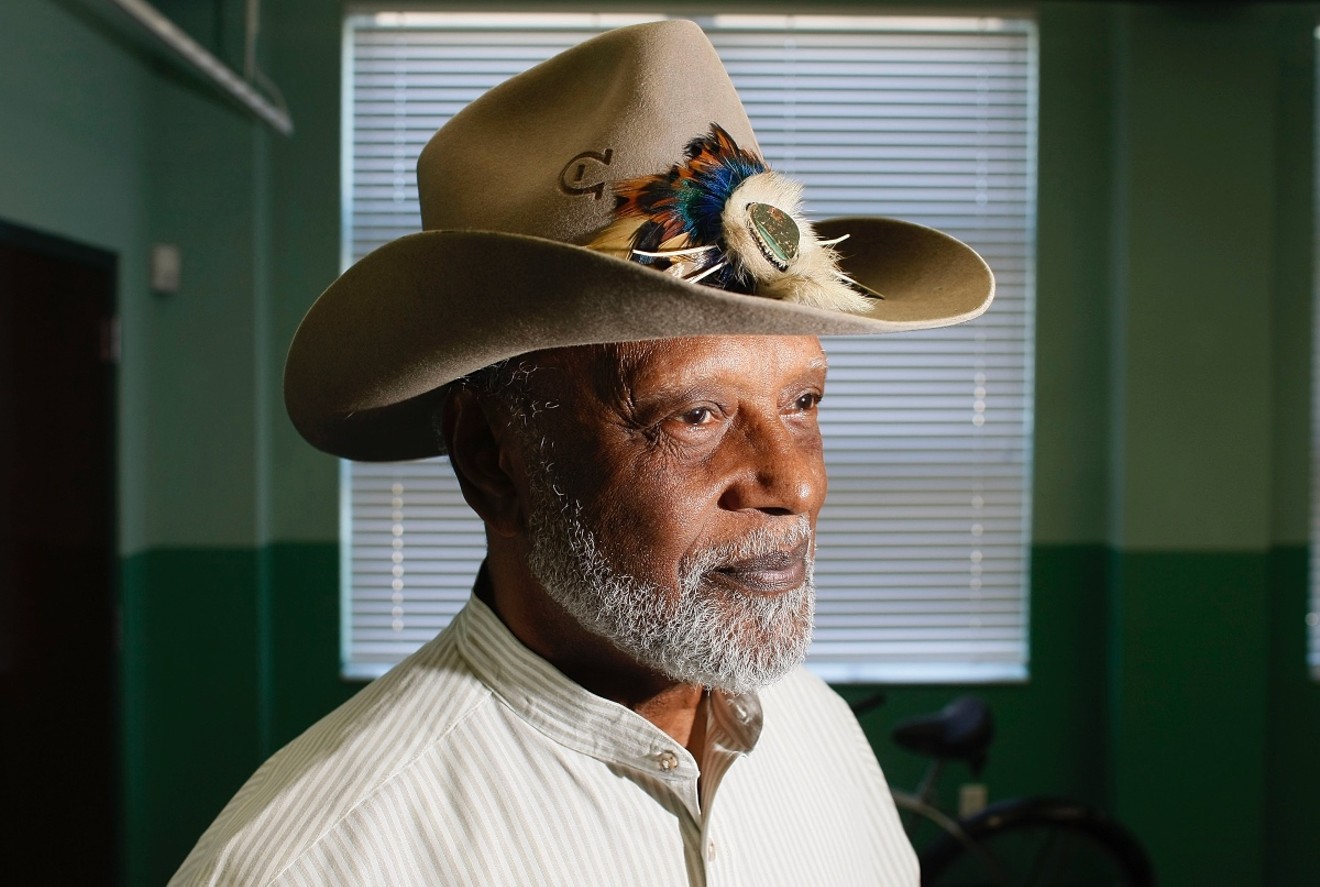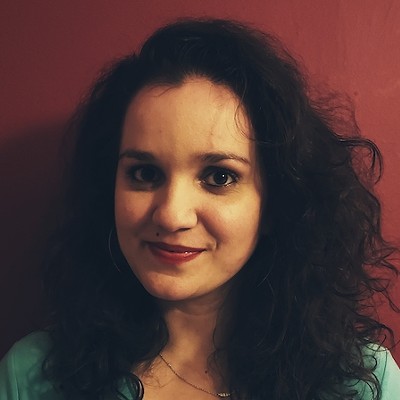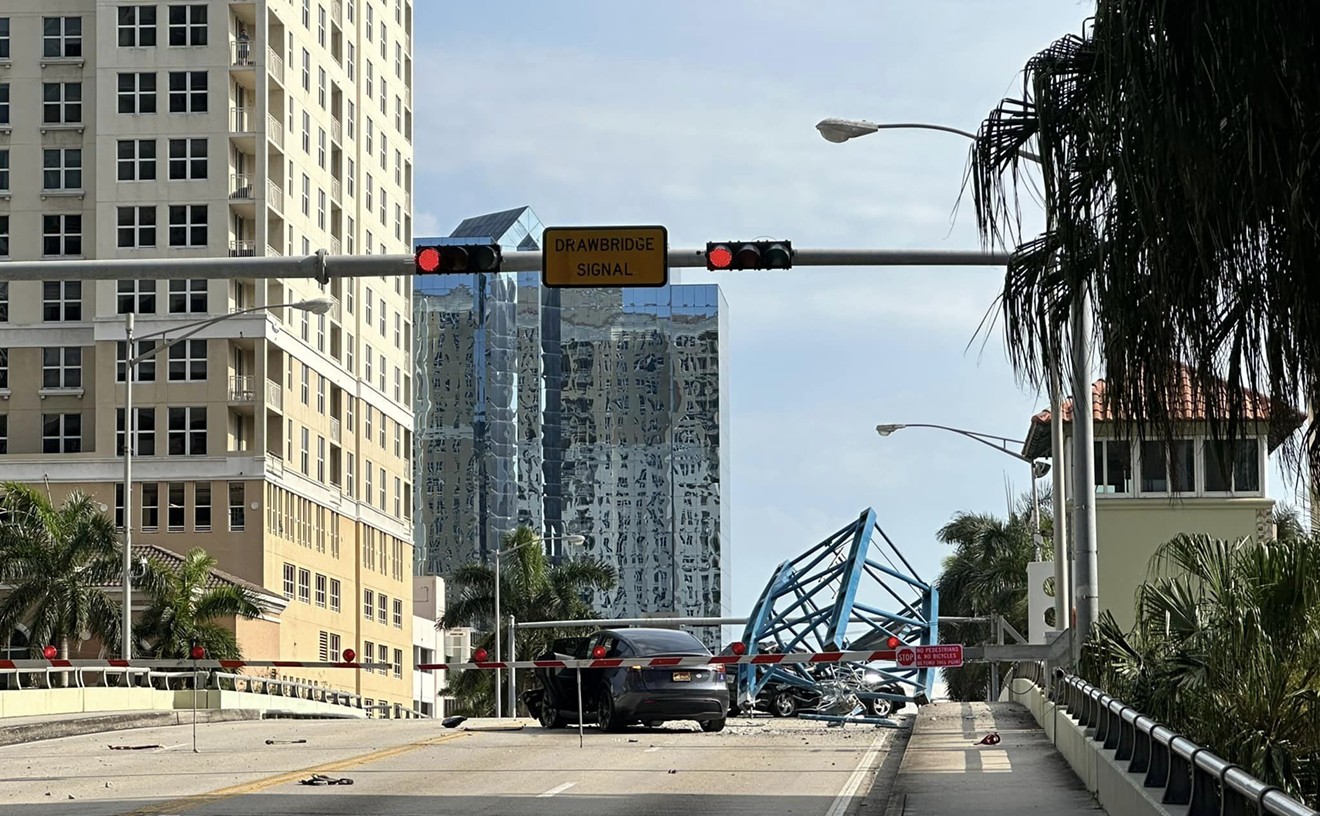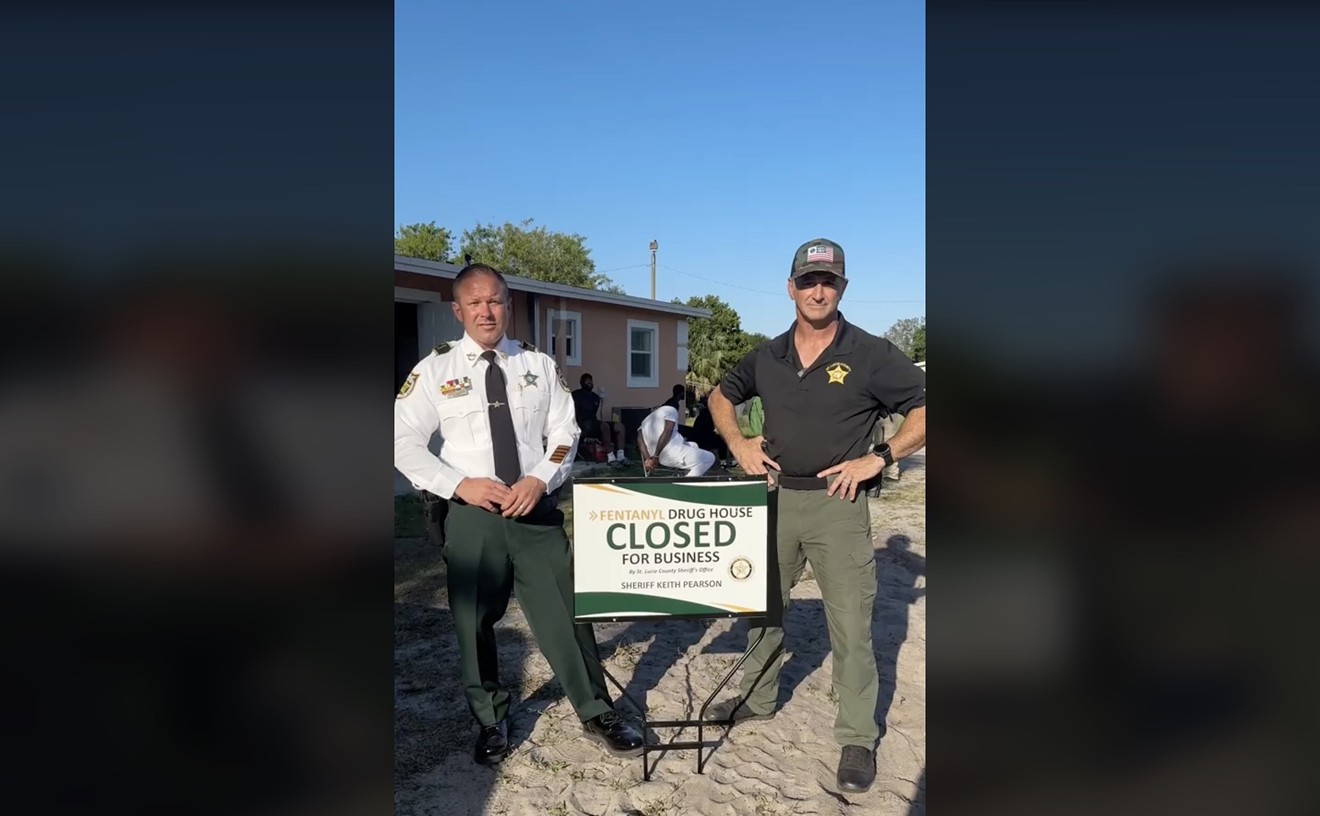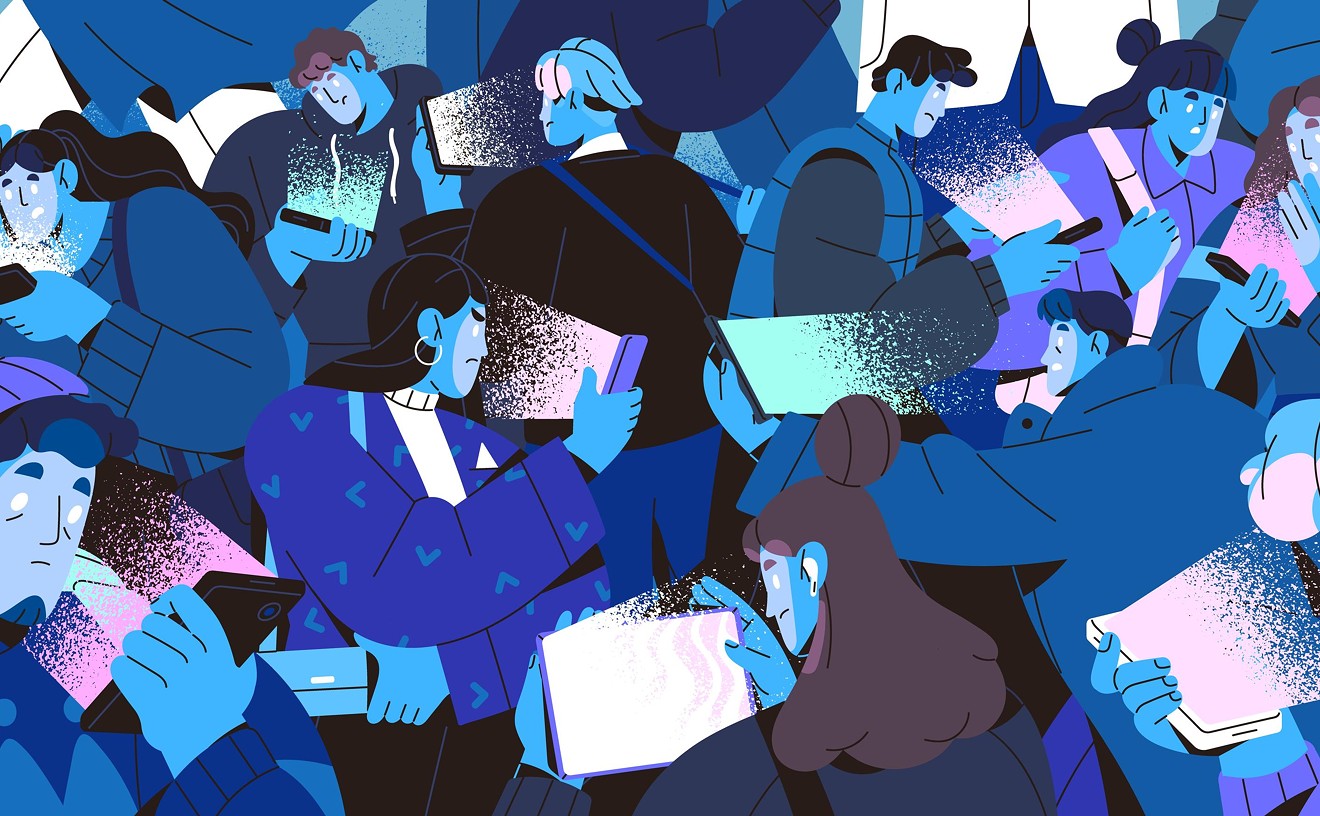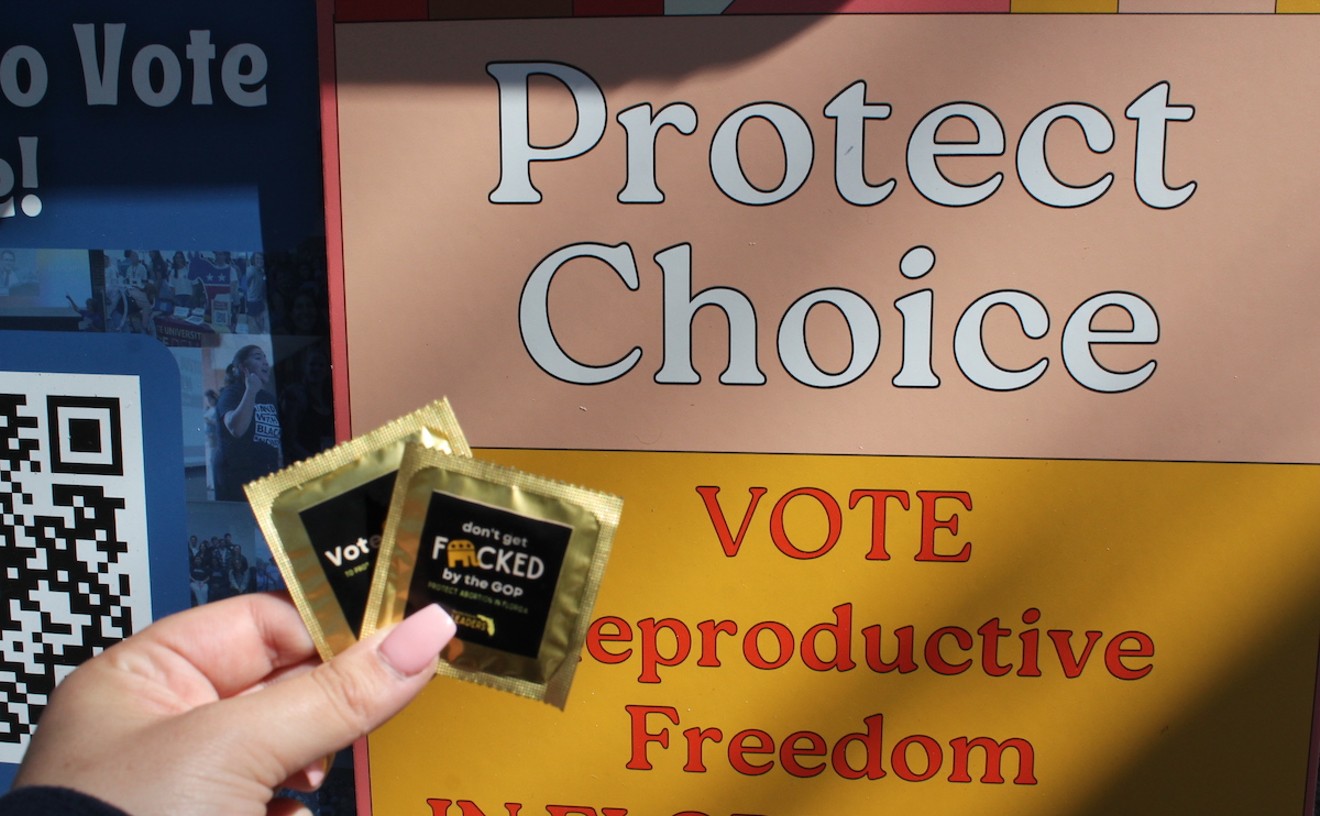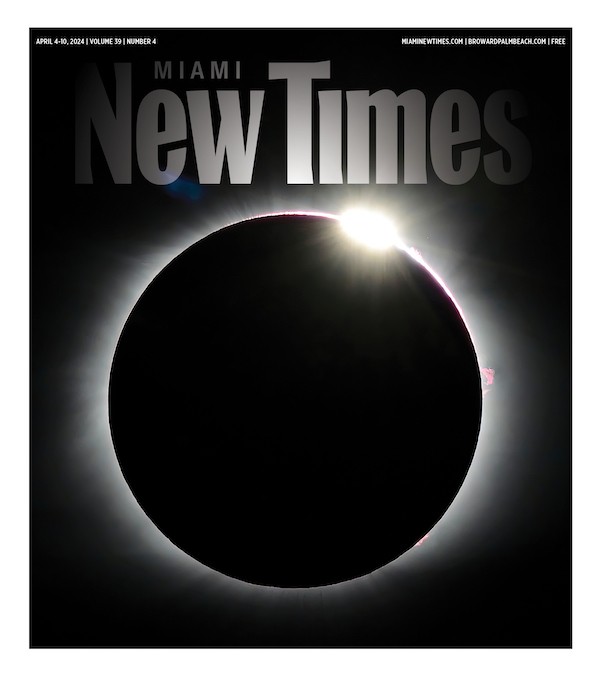That year, Clarence Dickson posed for a graduation photo along with a dozen white officers who made it through the police college. Afterward, Dickson was given a copy of the picture, which showed the men grouped together in their new blue-and-gray uniforms, guns, and badges. But that image never made it onto the wall.
"What I didn't know at the time was that after taking the photo, they called the class back without me and took the picture again," Dickson says. "The photo on the wall of graduates was an all-white graduating class."
But the department couldn't erase Dickson. He rose through the ranks and became Miami's first Black chief of police in 1985. While Dickson's photo isn't hanging on the walls of the police academy, the building will now bear his name in perpetuity. This week, the Miami Police Department officially renamed the police academy the Chief Clarence Dickson Police College.
Dickson tells the graduation-photo story as though the memory is still fresh. During the renaming ceremony on Tuesday, he told it once more.
What happened, he says, was disheartening and irritating. But now, there's a new ending to the old story.
In the words of Dickson's wife, Gwendolyn, a former Miami Beach police dispatcher: "Clarence, to hell with the photo. The whole college has been named in your honor."

Former Miami police chief Clarence Dickson, center, and his wife Gwendolyn, left.
Photo by the Miami Police Department
"You know what?" Dickson said to himself. "That guy's coming back, I bet you."
The officer drove around the block, parked in front of the bus stop, rolled his window down, and asked Dickson what he was doing there.
"I'm waiting on the bus," Dickson said.
"Oh, yeah?" the officer said. "What are you really doing?"
"I'm waiting for the bus," Dickson said again.
The officer gave a big, generous smile, like he was accustomed to showing teeth. He got out of the car and approached Dickson.
"I know I'm being cute, but so are you," the officer said. "Do you have identification?"
Dickson showed the officer his ID and answered all of his questions. His car wasn't working and he was trying to get to work, so he needed to take the bus.
The officer was the first Black cop Dickson had ever seen, and he was impressed with how he handled stopping a fellow Black man. The exchange at the bus stop was an interrogation, no doubt. But it almost felt conversational. By the time it was over, Dickson knew as much about the officer as the officer knew about him.
Before driving off, the officer told Dickson, "If you're up this time of morning and you got a job, you'd probably make a good cop." He suggested that Dickson take the civil-service exam to qualify.
Dickson laughed. "Yeah, right," he said. But ultimately, he gave the officer's advice some thought.
"He was the one that gave me the impression that I could and would be a good cop, regardless of what I'd heard about the police," Dickson tells New Times. "Everything I'd heard about the police up to that point had not been good, but this guy changed my opinion about what I'd heard about the police. I thought about that. I thought I would never be a cop. I thought I couldn't be a cop. But I went ahead and put in for civil service."
Dickson applied to become an officer with the City of Miami Police Department. He joined the department when it was still segregated and became the first Black officer to graduate from the Miami PD's training academy. He rose through the ranks to become a sergeant, a lieutenant, a captain, a commander, a major, a deputy chief, an assistant chief, and, ultimately, the city's first Black chief of police.
But before all of that, when Dickson was still in the academy, he worried he wouldn't make it through. He had failed two exams. One more, and he was out. Forty-four recruits had entered the academy, and only 13 would make it to graduation.
"It was a tough class," Dickson says.
Around the seventh week, the academy instructor told the recruits they were going to do ride-alongs with veteran officers to get a grip on what the job looked like. Dickson was sent to the Black police precinct in Overtown, now called the Black Police Precinct and Courthouse Museum.
A Black sergeant introduced Dickson and a second Black recruit to the officers at the station as "the first of us to go through that academy over there." Previously, Black police officers who'd been hired were trained peer-to-peer, not at the academy. The sergeant explained that the Black officers had been waiting for this for a long time and congratulated the city's Black police union for helping break that barrier.
Dickson says he was shocked to hear that. He hadn't realized he was standing inside a segregated police station. He didn't know he was among the first Black recruits to go through the police academy. And he didn't know the department's Black police union had been leading the fight.
After roll call, a Black officer pulled his new colleague to the side and told Dickson not to let him down. A lot was riding on his success. Dickson was told that white officers had a wager going with their Black counterparts that no Black officer would make it through the academy.
"We were being set up for failure because the administration didn't want Black officers in the academy," Dickson recounts. "They said it would be a waste of time."
He knew the Black recruit who was with him that day was failing the academy and on his way out. Dickson feared he was close to failing, too.
"It made me realize that it wasn't just about me. It was people depending on me. And that motivated me to do my very best to not get kicked out of the academy because of academics."
It wasn't easy. Growing up in Palatka, a small Florida town south of Jacksonville, Dickson had dropped out of school in tenth grade and started working to support his mother and two siblings. But the Black officer's words stuck with him. He had to succeed. It wasn't just about him; it was about all of the Black officers before him who didn't get a chance to go through the academy. It was a chance to move things forward rather than let them slip backward.
He finished second in his class. He says he would have been first if he'd taken the academy seriously from the beginning.
"Long story short, I did good," he says.
After graduating, Dickson reported every day to the Black police precinct and started patrolling Miami's historically Black neighborhoods. There was talk of integrating the department at the time, but because Black officers were prohibited from going to headquarters unless they were invited or chaperoned by a white superior, he didn't know the ins and outs of the integration talks.
Then Chief Walter Headley, one of Miami's notoriously racist police chiefs, called Dickson into his office to explain his new job.
In 1963, Headley assigned Dickson and another Black officer to "point control," a unit that worked downtown on Flagler Street and NE Second Avenue in the middle of daytime traffic. The intention was to get the community and white officers adjusted to seeing Black officers on the streets.
"What [Headley] was doing was preparing us for the integration of the police department," Dickson says. "Blacks couldn't arrest whites at the time. You had to call a white police officer or supervisor if it was a white giving them trouble. It was the first time these people had seen a Black officer, and I was thrown in their face working the busiest street corner in Miami."
Headley assigned a white partner to each Black officer. There were never two Black officers on the same point-control shift because Headley didn't want them to "cry on each other's shoulders" when things got tough, Dickson says.
"You stand on the corner, highly exposed," Dickson says. "You write tickets for jaywalking. Sometimes you had to fight people. You arrested white people. You converse and give information to the white tourists. You do that all day, and you can't go anywhere."
Dickson recalls that on his first day of downtown point control, a white officer quit the force because he couldn't work with "those negro officers." Radio talk shows brought in guests who said that Black officers had no business in downtown and no business arresting white people, while others called in to support the new policy.
At first, people would stand across the street from Dickson and simply stare.
"I felt like a fish in a fishbowl," he says.
After about three months, though, he felt like he was on solid footing. Residents and visitors liked him. Some brought him fruits and snacks. In his four years working downtown, one of his proudest moments was arresting a bank robber without firing a shot.
"I faced down a gunman who pulled a gun on me in a crowd of downtown people who watched and stared like idiots instead of moving away," he explains.
From downtown, Dickson went back to regular patrol. A lot had changed in four years. The department had integrated and allowed women on the force, but Dickson noticed a lack of leadership that made him resolve to work his way up.
Dickson passed the sergeant's exam in 1970 and the lieutenant's exam in 1975. His wife helped him through every promotion. She would record audio of herself reading his textbooks, and he'd come home from work to listen to the tapes and take notes.
The academy set Dickson up for success, but that came with mixed emotions each time he was promoted. He felt he had to hold himself to a higher standard — so many police officers before him had fought for the right to attend the academy and paved the way for his success. But his success empowered him to try to make the department a better place.
Always wearing his distinctive cowboy hat and pressed uniform, Dickson was known as a man who carried himself with dignity and elegance.
"He was an admirer of his grandfather and uncle, who inspired him," says Terrance Cribbs-Lorrant, director of the Black Police Precinct and Courthouse Museum. "Hence the reason for the cowboy hat. He admired the life not of a cowboy, but of a farmer and hard worker. In my mind, it represents a man who had a man in his life who showed him a better way of life."
Promoted to chief in 1985, Dickson led the Miami Police Department during a period of intense internal corruption. Not long after he took over, the Miami River cops scandal shook the city.
That summer, a fishing boat loaded with millions of dollars' worth of cocaine made its way up the Miami River and docked at the Jones Boat Yard. Six men offloading the cocaine were surprised by six police officers raiding the boat. The officers yelled, "Kill them!" The men jumped overboard. Three of them drowned. The cocaine disappeared.
During that time, about 100 officers were arrested, fired, reprimanded, or suspended for their roles in a range of drug ripoffs and killings.
Dickson, according to media coverage at the time, appointed an internal squad to investigate corruption among officers. He cooperated with the FBI and other outside investigators and informed the public of what was happening. He also supported criminal prosecution of officers that different police administrations might have handled more quietly.
At the direction of the city manager at the time, Dickson also created new anti-corruption policies. He increased supervision and overhauled the property unit to keep a closer eye on personnel and prevent evidence from going missing. HR adopted more stringent hiring, background-check, and psychological-testing procedures. That allowed the department to step up hiring standards in general, which had been relaxed when massive numbers of officers needed to be hired in the wake of the Mariel boatlift and the McDuffie riots in 1980.
"Thank God for Clarence Dickson," Miami city manager Cesar Odio said of the former chief in a 1988 Miami Herald story. "He was in the right place at the right time for the Miami Police Department. His honesty and integrity was exactly the right thing they needed at the police department when they were going through this corruption scandal."
But, as is typical in Miami, politics led to Dickson's abrupt retirement in 1988. As one Herald article put it:
Of the battles Dickson had faced in his 3 ½ years as a chief — corrupt cops, murdered cops, disloyal cops — he realized that [City Hall] politics was the fight he could not win. Dealing with commissioners had become harder than dealing with the River Cops scandal.According to media coverage at the time, commissioners thought Dickson still wasn't doing enough to address the city's corrupt cops and drug problems.
In his first public speech after his retirement, Dickson told members of the Rotary Club of Miami that commissioners time and time again painted him and his officers as "a bunch of stumblebums."
He cited "an accumulation of politically related incidents" as the reason for his departure, including the asphyxiation of an officer who was killed by carbon monoxide fumes in his police car. Dickson blamed an old, dilapidated police car and said he could never forgive the commission for "refusing to hear my pleas for cars so that my officers would have safe vehicles to ride in," according to a Herald story.
Nevertheless, after his retirement, Dickson continued to represent the police department in various capacities. He shared his story in the media and attended department events. He developed a close relationship with Cribbs-Lorrant, the Black Police Precinct and Courthouse Museum director; to this day he agrees to take part in speaking engagements whenever he's asked to.
A few years ago, the museum curated an exhibit dedicated to Dickson. Cribbs-Lorrant says the former chief has left an indelible mark on Miami's Black history.
"We don't know a lot of these things because we haven't put it out there, and we hide from our accomplishments," Cribbs-Lorrant says. "How many years did I know Chief Dickson before I realized who he was? How many grandparents do incredible things and we don't sit at their feet, and we don't know about them until their funeral or until you read their obituary? That's why I've tried to get him to come out."
The Miami Community Police Benevolent Association (MCPBA), the union that represents Miami's Black police officers, and community activists have advocated for years to rename the Police College after Dickson.

(Left to right) MCPBA vice president Ramon Carr, sergeant-at-arms Travis Lindsey, and president Stanley Jean-Poix in front of a plaque dedicating the Chief Clarence Dickson Police College.
Photo courtesy of the Miami Community Police Benevolent Association
"I just want to show people that we do matter, and we have a history here," he says. "We're an important part of the department. Chief Dickson paved the way for Black officers to succeed in the academy and rise through the ranks. That's his legacy. I try to pay homage to the people that paved the way for me. I feel like that's my legacy."

